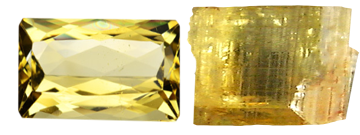 Photo of Heliodor Beryl in Processed & Rough Form
Photo of Heliodor Beryl in Processed & Rough Form
Heliodor Beryl is a mineral with a hardness of 8 out of 10 on the Mohs scale of mineral hardness [?]. These Hexagonally structured gems are made of beryllium aluminum silicate, their full chemical compound being Be3Al2(SiO3)6.
Heliodor is a gem variety of Beryl with golden-yellow or light yellow-green color. In many cases heliodor is also used to include gems known as Golden beryl/ Golden emerald, though not to be confused with gold beryl. It is sometimes hard to establish a dividing line between heliodor and golden beryl.
Its main characteristic is its color, which is the yellow-green of olive oil. Its pigment is uranium oxide, radioactive.
Yellower versions can look very much like olivine, and is very similar to chrysoberyl and some yellow-green tourmalines, but the difference can be easily established by measuring its physical characteristics.
It is pegmatite-hosted, and like all beryls, occurs as prismatic crystals, which are sometimes terminated with small pyramids. The crystals are often striated parallel to their length, and may be of vast size; specimens up to 18 feet long have been recorded. It also forms in massive, compact, and columnar habits. It is transparent to translucent, with a vitreous luster.
Yellow beryls are obtained from practically all the localities mentioned for aquamarine. Particular localities are Madagascar, Brazil and Namibia. In Namibia, heliodor is found in association with aquamarine and a yellowish green variety at Klein Spitzkopie near Rossing on the Otavi railway east of Swakopmund, and also between Aiais and Gaibes on the Fish river. Some yellow beryls have been reported to show radioactivity due to their containing a trace of uranium oxide. A deep yellowish red variety of beryl, called "berilo bocade fogo" (fire-mouth beryl), comes from Santa Maria do Suassui in Minas Gerais (Brazil). Many localities in the USA produce yellow beryl but the only one of importance is the Merryall or Roebling mine at New Milford, Connecticut.
Other names for heliodor include eliodoro (Italian), heliodoro (Spanish)
The specific gravity [?] for Heliodor Beryl is 2.8, it's refractive index [?] is 1.57-1.58, and it's double refraction [?] is 0.005.
History
Heliodor has a name coined fairly recently, meaning "sun-gilded" or "gift of the sun." In olden times, heliodor was known as "chrysoberyl." It was discovered in 1910 in Namibia, but similar stones had previously been known in Brazil and Madagascar.
Industrial Usages
Brightly colored specimens of Golden beryl are in demand with collectors and connoisseurs but among the lesser varieties of beryl, it is not one of the most valuable. On the other hand, Heliodor is valued by collectors at least as highly as aquamarine, and is not common on the market.
The normally medium or largish stones are generally given an oval, or more rarely, a step cut. They may have the liquid inclusions typical of beryl, but are usually quite clear.






